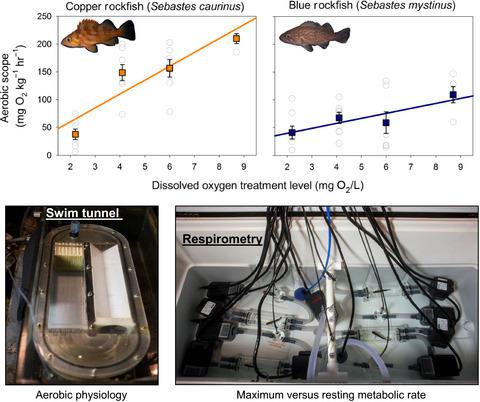当前位置:
X-MOL 学术
›
Glob. Change Biol.
›
论文详情
Our official English website, www.x-mol.net, welcomes your feedback! (Note: you will need to create a separate account there.)
Effects of hypoxia on the behavior and physiology of kelp forest fishes.
Global Change Biology ( IF 11.6 ) Pub Date : 2020-04-08 , DOI: 10.1111/gcb.15076 Evan G Mattiasen 1 , Neosha S Kashef 2, 3 , David M Stafford 2, 3 , Cheryl A Logan 4 , Susan M Sogard 2 , Eric P Bjorkstedt 2, 5 , Scott L Hamilton 1
Global Change Biology ( IF 11.6 ) Pub Date : 2020-04-08 , DOI: 10.1111/gcb.15076 Evan G Mattiasen 1 , Neosha S Kashef 2, 3 , David M Stafford 2, 3 , Cheryl A Logan 4 , Susan M Sogard 2 , Eric P Bjorkstedt 2, 5 , Scott L Hamilton 1
Affiliation

|
Forecasts from climate models and oceanographic observations indicate increasing deoxygenation in the global oceans and an elevated frequency and intensity of hypoxic events in the coastal zone, which have the potential to affect marine biodiversity and fisheries. Exposure to low dissolved oxygen (DO) conditions may have deleterious effects on early life stages in fishes. This study aims to identify thresholds to hypoxia while testing behavioral and physiological responses of two congeneric species of kelp forest fish to four DO levels, ranging from normoxic to hypoxic (8.7, 6.0, 4.1, and 2.2 mg O2 /L). Behavioral tests identified changes in exploratory behavior and turning bias (lateralization), whereas physiological tests focused on determining changes in hypoxia tolerance (pCrit), ventilation rates, and metabolic rates, with impacts on the resulting capacity for aerobic activity. Our findings indicated that copper rockfish (Sebastes caurinus) and blue rockfish (Sebastes mystinus) express sensitivity to hypoxia; however, the strength of the response differed between species. Copper rockfish exhibited reduced absolute lateralization and increased escape time at the lowest DO levels, whereas behavioral metrics for blue rockfish did not vary with oxygen level. Both species exhibited decreases in aerobic scope (as a function of reduced maximum metabolic rate) and increases in ventilation rates to compensate for decreasing oxygen levels. Blue rockfish had a lower pCrit and stronger acclimation response compared to copper rockfish. The differences expressed by each species suggest that acclimatization to changing ocean conditions may vary, even among related species that recruit to the same kelp forest habitat, leading to winners and losers under future ocean conditions. Exposure to hypoxia can decrease individual physiological fitness through metabolic and aerobic depression and changes to anti-predator behavior, with implications for the outcome of ecological interactions and the management of fish stocks in the face of climate change.
中文翻译:

低氧对海带森林鱼类行为和生理的影响。
气候模型和海洋学观测的预测表明,全球海洋中的脱氧现象不断增加,沿海地区缺氧事件的频率和强度增加,这有可能影响海洋生物多样性和渔业。暴露于低溶解氧(DO)条件下可能会对鱼类的早期生命阶段产生有害影响。这项研究旨在确定低氧阈值,同时测试两种同种海带森林鱼对从常氧到低氧(8.7、6.0、4.1和2.2 mg O2 / L)的四个DO水平的行为和生理反应。行为测试确定了探索行为的变化和转向偏见(偏侧化),而生理测试则侧重于确定低氧耐受性(pCrit),通气率和代谢率的变化,对有氧活动能力的影响。我们的发现表明,铜岩鱼(Sebastes caurinus)和蓝岩鱼(Sebastes mystinus)对缺氧敏感。但是,响应的强度因物种而异。铜岩鱼在最低的溶解氧水平下表现出绝对的侧向化降低和逃逸时间增加,而蓝色岩鱼的行为指标并没有随氧气水平的变化而变化。两种物种都表现出有氧运动范围的减少(作为最大代谢速率降低的函数)和通气速率的增加,以补偿氧气含量的降低。与铜石鱼相比,蓝色石鱼的pCrit较低,适应性较强。每个物种表达的差异表明,适应不断变化的海洋条件可能会有所不同,甚至招募到相同海带森林栖息地的相关物种中,在未来的海洋条件下也会导致赢家和输家。缺氧会通过代谢和有氧抑郁并改变反捕食者的行为而降低个体的生理适应性,对生态相互作用的结果和面对气候变化的鱼类种群的管理产生影响。
更新日期:2020-03-09
中文翻译:

低氧对海带森林鱼类行为和生理的影响。
气候模型和海洋学观测的预测表明,全球海洋中的脱氧现象不断增加,沿海地区缺氧事件的频率和强度增加,这有可能影响海洋生物多样性和渔业。暴露于低溶解氧(DO)条件下可能会对鱼类的早期生命阶段产生有害影响。这项研究旨在确定低氧阈值,同时测试两种同种海带森林鱼对从常氧到低氧(8.7、6.0、4.1和2.2 mg O2 / L)的四个DO水平的行为和生理反应。行为测试确定了探索行为的变化和转向偏见(偏侧化),而生理测试则侧重于确定低氧耐受性(pCrit),通气率和代谢率的变化,对有氧活动能力的影响。我们的发现表明,铜岩鱼(Sebastes caurinus)和蓝岩鱼(Sebastes mystinus)对缺氧敏感。但是,响应的强度因物种而异。铜岩鱼在最低的溶解氧水平下表现出绝对的侧向化降低和逃逸时间增加,而蓝色岩鱼的行为指标并没有随氧气水平的变化而变化。两种物种都表现出有氧运动范围的减少(作为最大代谢速率降低的函数)和通气速率的增加,以补偿氧气含量的降低。与铜石鱼相比,蓝色石鱼的pCrit较低,适应性较强。每个物种表达的差异表明,适应不断变化的海洋条件可能会有所不同,甚至招募到相同海带森林栖息地的相关物种中,在未来的海洋条件下也会导致赢家和输家。缺氧会通过代谢和有氧抑郁并改变反捕食者的行为而降低个体的生理适应性,对生态相互作用的结果和面对气候变化的鱼类种群的管理产生影响。


























 京公网安备 11010802027423号
京公网安备 11010802027423号